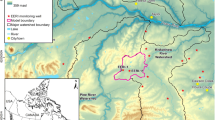Abstract.
Relatively recent recognition of the importance of endogenous lava emplacement mechanisms requires updating of groundwater models for some volcanic terranes because voids produced during lava inflation play a more significant role in their hydrogeology than has generally been recognised. Highly integrated, underground drainage systems in some very young lava flows in Iceland exemplify the potentially complex, fissured and conduit aquifers which may exist. Similarities between such aquifers and easily polluted, karstic conduit aquifers suggest greater research and more careful and protective management of some volcanic aquifers are warranted. Interpretation of aquifer structure can be impeded on very old lava flows by superimposition of sediments and accumulation of weathering residues but, if emplacement was by endogenous processes, then relicts of similar void systems may persist and pose similar hazards.
Similar content being viewed by others
Author information
Authors and Affiliations
Additional information
Electronic Publication
Rights and permissions
About this article
Cite this article
Kiernan, .K., Wood, .C. & Middleton, .G. Aquifer structure and contamination risk in lava flows: insights from Iceland and Australia. Env Geol 43, 852–865 (2003). https://doi.org/10.1007/s00254-002-0707-8
Received:
Accepted:
Issue Date:
DOI: https://doi.org/10.1007/s00254-002-0707-8




